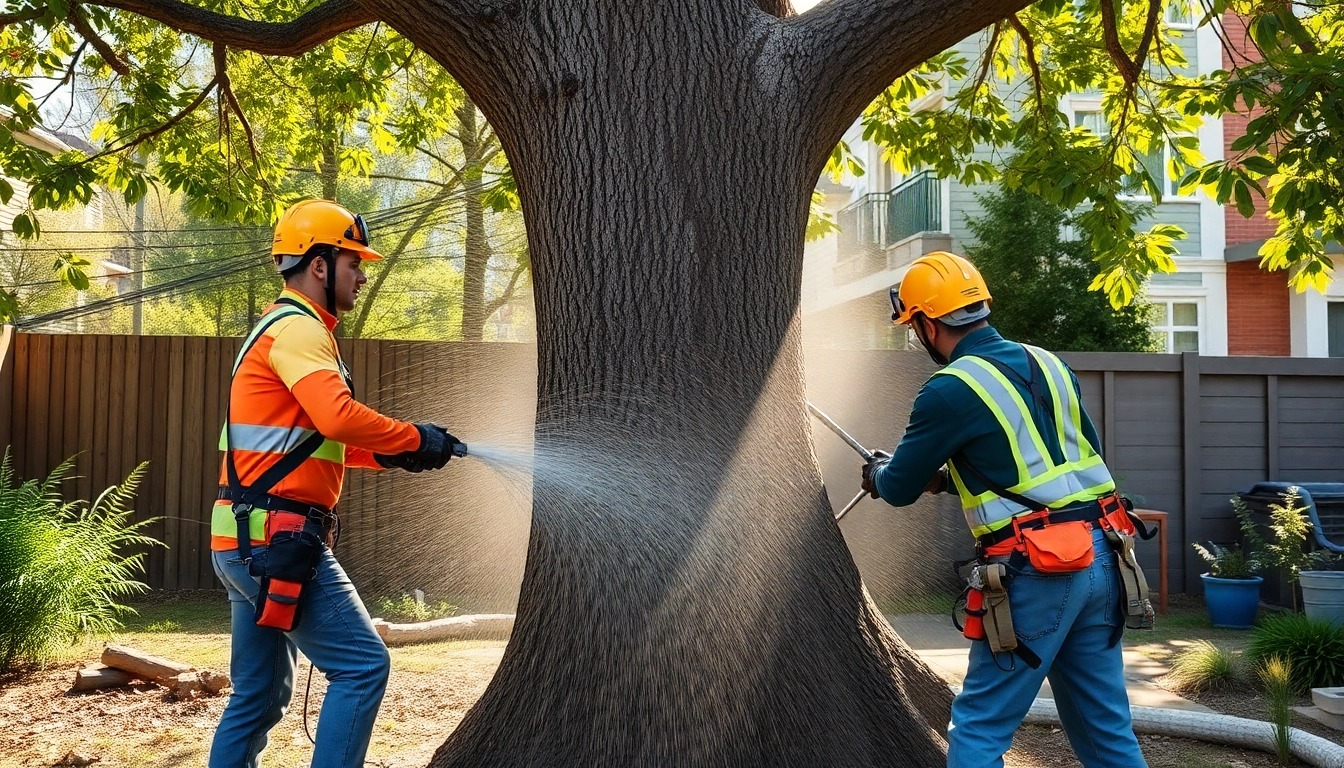Understanding Emergency Tree Service Needs
When the winds pick up, or a sudden storm rolls in, your trees may become a source of anxiety rather than tranquility. An emergency tree service is essential for addressing unforeseen events that can threaten both your property and personal safety. Understanding the nuances of emergency tree services can help you act swiftly when disaster strikes. This article dives deep into everything you need to know about emergency tree services, from recognizing severe situations to choosing the right provider.
What Constitutes an Emergency Tree Situation?
An emergency tree situation can be defined as any instance where a tree or part of a tree poses an immediate threat to people, property, or neighboring vegetation. Common examples include:
- Storm Damage: Trees or branches that have fallen or are at risk of falling due to wind, rain, or snow accumulation.
- Diseased or Dying Trees: Trees suffering from severe disease or infestation that may collapse unexpectedly.
- Roots Uprooting: Trees whose roots have been significantly disturbed, leading to instability.
- Blocked Access: Trees blocking crucial access points like driveways or roads after falling.
The urgency of needing professional intervention cannot be overstated during such events, as delaying action may lead to more dangerous situations.
Signs You Need Emergency Tree Service
Recognizing the signs that indicate a need for emergency tree service is vital. Here are a few key indicators:
- Visible Damage: Large cracks or splits in the trunk or major branches suggest that a tree is compromised.
- Leaning Trees: A tree that has suddenly shifted position, leaning unnaturally, likely indicates an urgent need for assessment.
- Broken Branches: Large, broken branches that are hanging precariously can lead to additional hazards.
- Dead or Discolored Leaves: Trees that have suddenly dropped leaves or exhibit signs of decay can be unstable.
Ensuring you have the right contacts in place can expedite the process and minimize damage.
Assessing the Severity of Tree Damage
Before calling for emergency tree services, it’s important to assess the damage level. Follow these steps for an initial assessment:
- Visual Inspection: Look for obvious signs of damage from a safe distance.
- Ground Inspection: Assess the area around the tree for fallen branches or debris.
- Check the Base and Trunk: Look for cracks, splits, or signs of decay.
- Observe Nearby Structures: Consider how a falling tree could affect homes, cars, or power lines.
If the damage appears severe or you are uncertain, it is always best to consult a professional rather than risking personal safety.
Choosing the Right Emergency Tree Service Provider
When faced with a tree emergency, selecting the right service provider equips you with peace of mind. Here are essential guidelines for making the right choice.
Key Qualifications to Look For
Not all tree service providers are created equal. Here are qualifications to ensure you choose a reliable one:
- Certifications: Look for qualifications from associations like the International Society of Arboriculture (ISA).
- Insurance: Ensure they have liability and worker’s compensation insurance to protect you from potential claims.
- Experience: A company with years of experience is more likely to handle emergencies effectively.
- Local Knowledge: Familiarity with your area’s common tree species and local regulations is vital.
How to Check Reviews and Ratings
In today’s digital age, online reviews can be invaluable in evaluating tree service providers. Here’s how to leverage them:
- Use Multiple Platforms: Check reviews on platforms like Google, Yelp, and Angie’s List to get varied perspectives.
- Look for Consistent Feedback: Identify patterns in reviews; repeated complaints can indicate systemic issues.
- Check Social Media: Social channels often contain real-time feedback about services.
- Ask for References: A reputable company should gladly provide references from past clients.
Thorough research can save time and stress later when emergencies arise.
Questions to Ask Before Hiring
Asking the right questions is crucial when negotiating emergency tree services. Here are some essential inquiries:
- What are your prices, and do you provide a written estimate?
- What techniques will you use for tree removal, and what are the risks involved?
- How quickly can you respond to an emergency call?
- Do you have customer service available for follow-ups or emergencies after hours?
Asking these questions ensures that you not only get efficient service but also clear communication throughout the process.
Emergency Tree Service Solutions
Understanding the mechanics behind emergency tree services can help you appreciate the solutions provided. Here are common methods and considerations involved.
Common Techniques Used in Tree Removal
Emergency tree service professionals utilize a variety of techniques, which can vary in complexity depending on the situation. Some common methods include:
- Height Reduction: Involves cutting down tree height gradually using climbers or aerial lifts.
- Sectional Cutting: Removing a tree in sections, especially useful for trees near buildings.
- Stump Removal: After tree removal, stumps can be ground down or extracted entirely.
Each method has its own risks and benefits, which should be assessed by professionals.
Tools and Equipment Employed by Professionals
Professionals use specialized tools to ensure tree removal is safe and efficient. Notable equipment includes:
- Chainsaws: Essential for cutting through thick trunks and branches.
- Aerial Lifts: Allow access to high branches without risking climbing.
- Wood Chippers: Convert debris into mulch, reducing disposal needs.
- Protective Gear: Helmets, gloves, and goggles ensure the safety of the workers.
Utilizing the right equipment is vital for minimizing risks and ensuring job completion.
Cost Considerations for Emergency Services
Costs for emergency tree services can vary widely based on location, the complexity of the job, and the equipment needed. Key factors affecting pricing include:
- Type of Service: Emergency responses cost more than routine services.
- Tree Size and Complexity: Larger trees or those in difficult locations will be more expensive to remove.
- Location: Urban areas may incur higher costs due to proximity to other structures.
- Time of Service: Services required after hours or on weekends may attract additional fees.
Getting multiple estimates can help in determining a fair price for emergency services.
Safety Measures and Best Practices
Safety is paramount when dealing with emergency tree services. Here are some best practices to ensure protection during an emergency.
Personal Safety Tips During Tree Emergencies
If you find yourself in a situation that may require emergency tree services, consider these personal safety tips:
- Maintain Distance: Stay at least 50 feet away from fallen trees or branches.
- Avoid Power Lines: Never attempt to move a tree or branches that are near power lines.
- Communicate Danger: Alert neighbors or others in the area of the potential risks.
- Wear Protective Gear: If you must approach, use gloves and hard hats.
Post-Service Safety and Property Checks
After tree services, conducting a thorough property check is important. Key checks should include:
- Inspect Surrounding Areas: Look for damaged structures or other trees that could be compromised.
- Check for Hazards: Ensure all branches and debris are removed from your property.
- Evaluate for Further Risk: Assess if there are any remaining trees that may pose future risks.
This oversight ensures continued safety and helps in mitigating future risks.
Regulatory Guidelines for Tree Removal
Before undertaking tree removal, it’s essential to be aware of local regulations. This may include:
- Permitting: Some locations may require permits for tree removal, even in emergencies.
- Protected Species: Certain trees may be protected under local laws and require special attention.
- Notification Processes: In some areas, notifying local authorities may be necessary.
Strict adherence to these regulations prevents potential legal issues after the fact.
Preventative Measures to Avoid Future Emergencies
Taking proactive steps can help in preventing tree emergencies in the future. This section explores best practices in tree care.
Regular Tree Maintenance and Inspections
Routine care and inspection can significantly reduce the risks associated with tree emergencies. Recommended practices include:
- Regular Pruning: Trimming weak or dead branches can help prevent unwanted damage in storms.
- Pest and Disease Management: Monitor trees for signs of infestation or disease to act before major issues arise.
- Soil Quality Assessment: Regularly check the soil for proper nutrients, as poor soil can destabilize roots.
Identifying Trees at Risk of Falling
Awareness of specific indicators can help identify trees at higher risk. Keep an eye out for:
- Gradual Leaning: Trees that have started leaning should be monitored closely.
- Root Issues: Exposure of roots can indicate instability.
- Decay Signs: Fungi or excessive dead wood can signal deeper structural issues.
Community Resources for Tree Health Education
Engaging with local resources can enhance your understanding of tree care. Explore these options:
- Workshops: Many local arborist groups offer sessions on tree health and maintenance.
- Tree Health Initiatives: Get involved in local community programs focused on urban forestry.
- Expert Consultations: Consulting local arborists can provide targeted advice for your property.
By actively participating in tree health education, you empower yourself to maintain a safer environment.



